Edelstein-Keshet L. Mathematical Models in Biology
Подождите немного. Документ загружается.


456
Spatially
Distributed
Systems
and
Partial
Differential
Equation
Models
is
which
of the
infinitely many possible speeds
is
most stable; this turns
out to be a
rather formidable theoretical question.
Fisher's
equation
is
simple enough that
an an-
swer
to
this problem could
be
given.
It was
shown
by
Kolmogorov
et al.
(1937) that
if
suitable initial conditions
are
assumed,
the
solution
of
equation (36) would evolve
into
a
traveling wave such
as
that
of
Figure
10.4(b)
and
would move
at the
minimal
wavespeed
vmin.
Readers interested
in
learning
further
details should consult Murray
(1977,
sec. 5.3).
Spreading
Colonies
of
Microorganisms
A
remarkable attribute
of
many living things
is an
ability
to
grow
in
size while main-
taining
a
particular shape
or
geometry. This property
is
common
in
advanced multi-
cellular
organisms where strong intercellular communication links
are
present.
It
also occurs
in
much more primitive settings such
as
populations
of
microorganisms,
although
the
underlying mechanisms might
be
rather
different.
Here
we
consider
the
nutrient-dependent growth
of
yeast cells
and
determine whether
a
colony
can
exhibit
a
coordinated spread over space.
Let us
focus
on the
growth
of
yeast under normal laboratory conditions.
A
typ-
ical experiment begins with
a
petri dish containing
a
small volume
of
sterile nutrient-
rich
medium. Usually
the
medium
is a
solidified
gel-like
substance
called
agar,
which
permits
free
diffusion
of
small molecules
and
provides
a
convenient two-di-
mensional surface
on
which
to
grow microorganisms.
A
small number
of
yeast cells
are
placed
on the
agar surface.
By
absorbing nutrient
from
below, they grow
and
multiply
to
such
an
extent that
the
population gradually expands
and
spreads over
the
surface
of the
substrate.
In
many cases,
the
shape
of the
colony remains essentially
unchanged
as it
grows
in
size.
Gray
and
Kirwan
(1974)
introduced
a
model
for the
spread
of
yeast
colonies
which,
with some modifications, will serve
as our
example.
A
colony
of
yeast usu-
ally takes
the
form
of a
glossy disk, visible
to the
naked eye, that continually
en-
larges
in
diameter.
We
will
find it
more convenient
to
deal with
a
one-dimensional
model
of the
colony,
as
depicted igure 10.5. Accordingly
we
define
the
follow-
ing:
n(x,
t) =
density
of
cells
at
location
x at
time
t,
g(x,
t) =
concentration
of
glucose
in
medium
at
location
x at
time
t.
Assuming that yeast
cells
undergo slight random motion
and
that they produce
progeny
only when glucose
is
sufficiently
abundant,
a
simple
set of
equations
to de-
scri ion would
be as
follows:
In
these equations
g\ is a
constant, representing
the
minima se nec-
essary
for
cell
proliferation.
The
yeast reproduction rate
is k(g –
g1); that
is,
cells
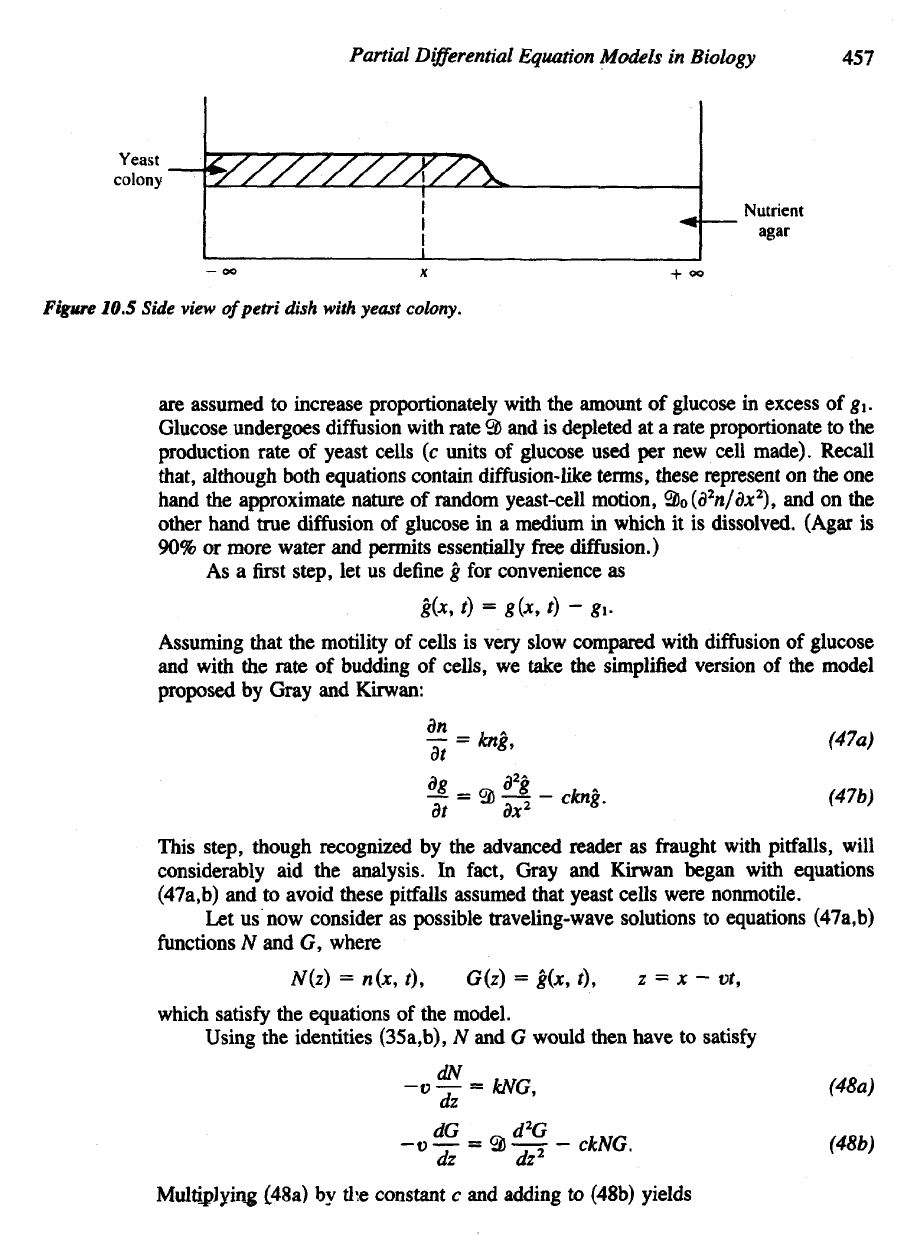
Partial
Differential
Equation
Models
in
Biology
457
Figure
10.5
Side view
of
petri
dish with yeast colony.
are
assumed
to
increase proportionately with
the
amount
of
glucose
in
excess
of g\.
Glucose undergoes
diffusion
with rate
2) and is
depleted
at a
rate proportionate
to the
production rate
of
yeast cells
(c
units
of
glucose used
per new
cell
made). Recall
that, although both equations contain diffusion-like terms, these represent
on the one
hand
the
approximate nature
of
random yeast-cell motion, 2)
0
(d
2
/i/d*
2
),
and on the
other hand true
diffusion
of
glucose
in a
medium
in
which
it is
dissolved. (Agar
is
90% or
more water
and
permits essentially
free
diffusion.)
As
a first
step,
let us
define
g for
convenience
as
This
step,
though recognized
by the
advanced reader
as
fraught
with
pitfalls,
will
considerably
aid the
analysis.
In
fact, Gray
and
Kirwan
began with equations
(47a,b)
and to
avoid these pitfalls assumed that yeast
cells
were nonmotile.
Let
us now
consider
as
possible traveling-wave solutions
to
equations (47a,b)
functions
N and G,
where
which
satisfy
the
equations
of the
model.
Using
the
identities
(35a,b),
N and G
would then have
to
satisfy
Multiplying (48a)
by the
constant
c and
adding
to
(48b)
yields
Assuming
that
the
motility
of
cells
is
very slow compared
with
diffusion
of
glucose
and
with
the
rate
of
budding
of
cells,
we
take
the
simplified version
of the
model
proposed
by
Gray
and
Kirwan:
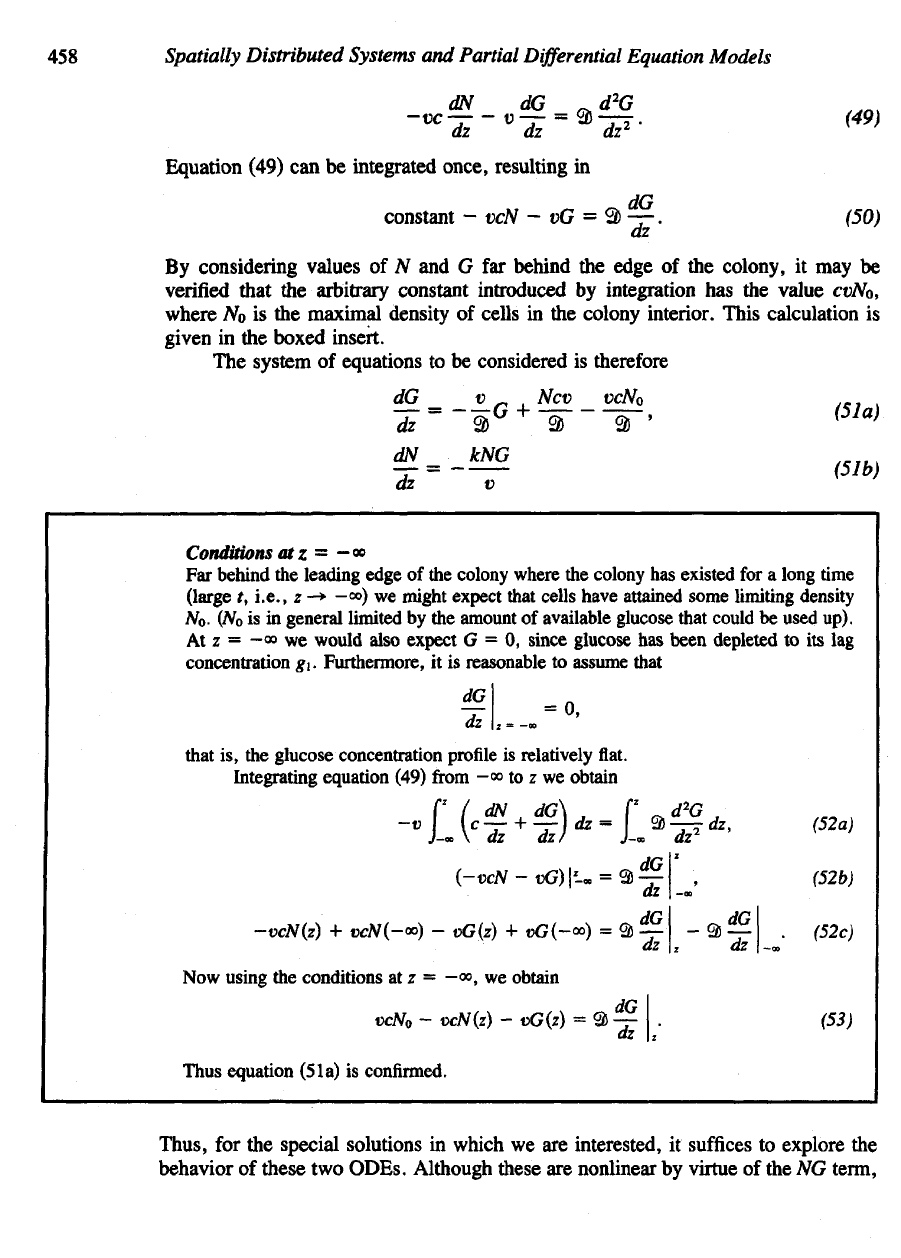
Spatially
Distributed
Systems
and
Partial
Differential
Equation
Models
By
considering values
of N and G far
behind
the
edge
of the
colony,
it may be
verified
that
the
arbitrary constant introduced
by
integration
has the
value cvN
0
,
where
No is the
maximal density
of
cells
in the
colony interior. This calculation
is
given
in the
boxed insert.
The
system
of
equations
to be
considered
is
therefore
Conditions
at z =
—
°°
Far
behind
the
leading edge
of the
colony where
the
colony
has
existed
for a
long time
(large
t,
i.e.,
z
—»
—») we
might expect that
cells
have attained some limiting density
N
0
.
(No
is in
general limited
by the
amount
of
available glucose that could
be
used up).
At
z =
—°°
we
would
also
expect
G = 0,
since
glucose
has
been depleted
to its lag
concentration
g\.
Furthermore,
it is
reasonable
to
assume that
that
is, the
glucose concentration
profile
is
relatively
fl
Integrating equation (49)
from
—
°° to z we
obtain
Thus,
for the
special
solutions
in
which
we are
interested,
it
suffices
to
explore
the
behavior
of
these
two
ODEs. Although these
are
nonlinear
by
virtue
of the NG
term,
Equation (49)
can be
integrated once, resulting
in
Now
using
the
conditions
at z =
—<»,
we
obtain
Thus equation (5la)
is
confirmed.
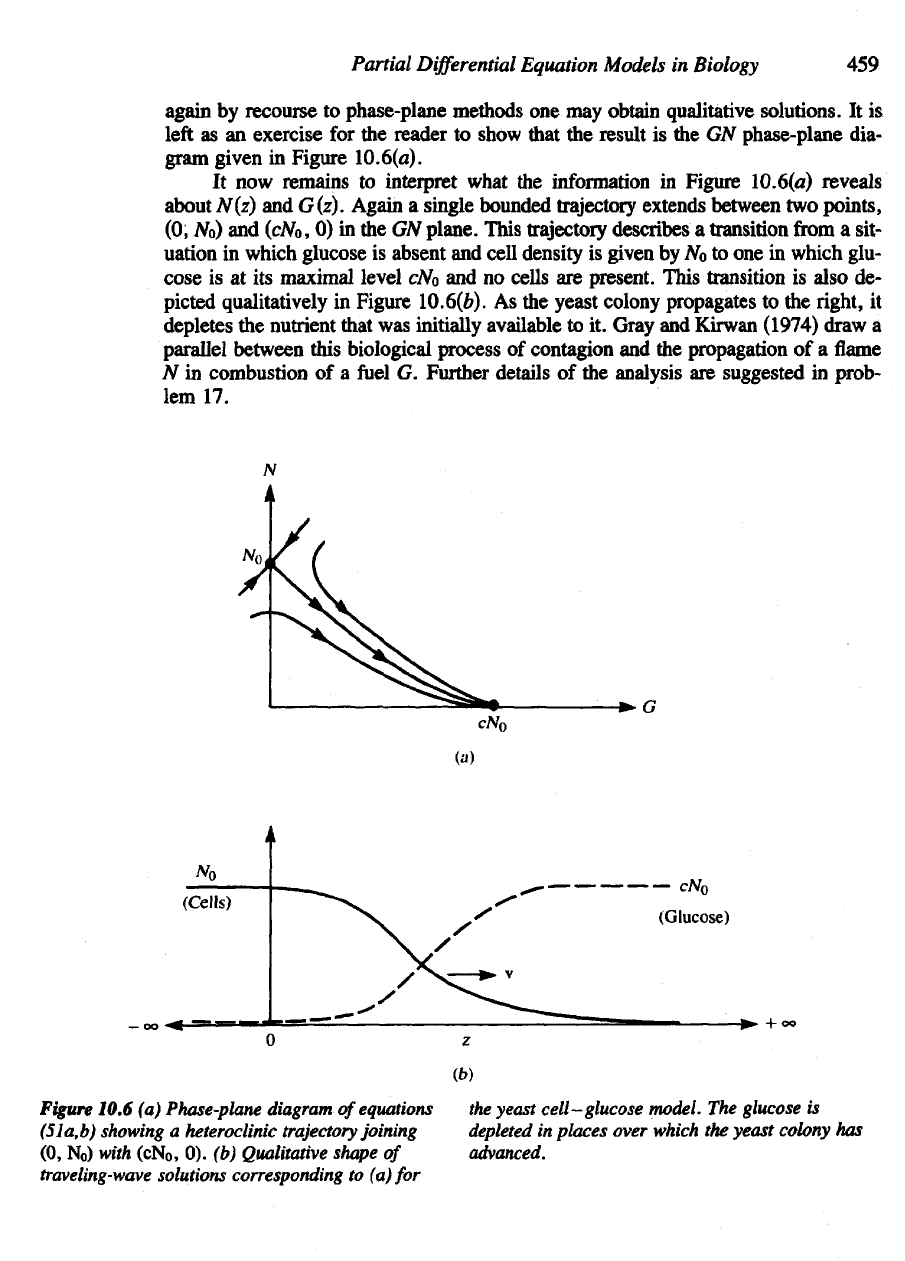
Partial
Differential
Equation
Models
in
Biology
459
again
by
recourse
to
phase-plan methods
one may
obtain qualitative solutions.
It is
left
as an
exercise
for the
reader
to
show that
the
result
is the GN
phase-plane dia-
gram
given
in
Figure
10.6(a).
It now
remains
to
interpret what
the
information
in
Figure
10.6(a)
reveals
about
N(z)
and
G(z). Again
a
single bounded trajectory extends between
two
points,
(0, No) and
(cN
0
,
0) in the GN
plane. This trajectory describes
a
transition
from
a
sit-
uation
in
which glucose
is
absent
and
cell
density
is
given
by
Afo
to one in
which glu-
cose
is at its
maximal level
cN
0
and no
cells
are
present. This transition
is
also
de-
picted qualitatively
in
Figure
10.6(6).
As the
yeast colony propagates
to the right, it
depletes
the
nutrient that
was
initially available
to it.
Gray
and
Kirwan (1974) draw
a
parallel between this biological process
of
contagion
and the
propagation
of a
flame
N
in
combustion
of a
fuel
G.
Further details
of the
analysis
are
suggested
in
prob-
lem
17.
Figure
10.6
(a)
Phase-plane
diagram
of
equations
(51a,b)
showing
a
heteroclinic
trajectory
joining
(0, NO)
with
(cN
0
,
0). (b)
Qualitative
shape
of
traveling-wave
solutions
corresponding
to
(a)
for
the
yeast
cell-glucose model.
The
glucose
is
depleted
in
places over which
the
yeast
colony
has
advanced.
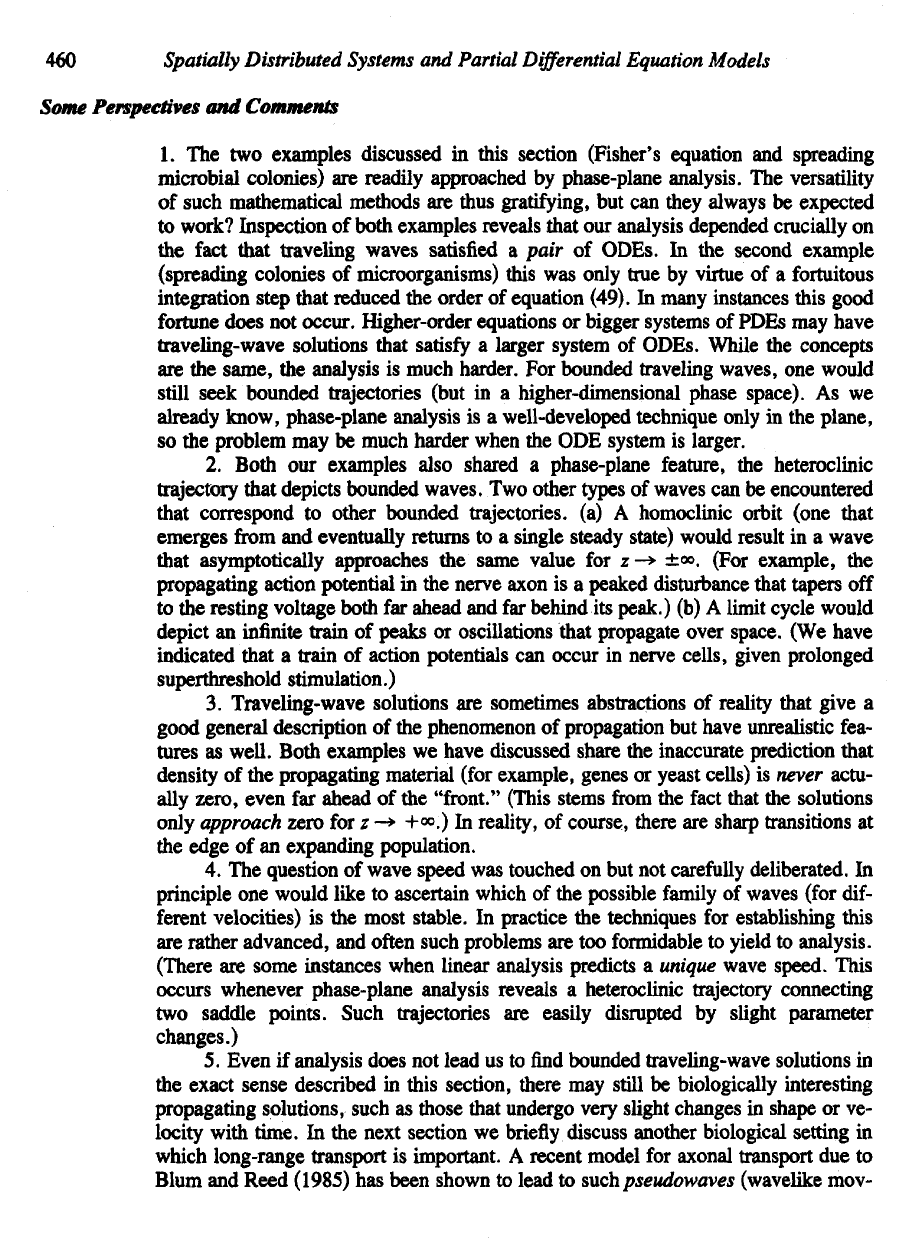
460
Spatially
Distributed
Systems
and
Partial
Differential
Equation
Models
Some
Perspectives
and
Comments
1. The two
examples discussed
in
this section (Fisher's equation
and
spreading
microbial
colonies)
are
readily approached
by
phase-plane analysis.
The
versatility
of
such mathematical methods
are
thus gratifying,
but can
they always
be
expected
to
work? Inspection
of
both examples reveals that
our
analysis depended crucially
on
the
fact that traveling waves satisfied
a
pair
of
ODEs.
In the
second example
(spreading
colonies
of
microorganisms) this
was
only true
by
virtue
of a
fortuitous
integration step that reduced
the
order
of
equation (49).
In
many instances this good
fortune
does
not
occur. Higher-order equations
or
bigger systems
of
PDEs
may
have
traveling-wave solutions that
satisfy
a
larger system
of
ODEs. While
the
concepts
are the
same,
the
analysis
is
much harder.
For
bounded traveling waves,
one
would
still
seek bounded trajectories (but
in a
higher-dimensional phase space).
As we
already know,
phase-plane
analysis
is a
well-developed technique only
in the
plane,
so the
problem
may be
much harder when
the ODE
system
is
larger.
2.
Both
our
examples also shared
a
phase-plane feature,
the
heteroclinic
trajectory
that depicts bounded waves.
Two
other types
of
waves
can be
encountered
that
correspond
to
other bounded trajectories,
(a) A
homoclinic orbit (one that
emerges
from
and
eventually returns
to a
single steady state) would result
in a
wave
that
asymptotically approaches
the
same value
for z-»
±00. (For example,
the
propagating action potential
in the
nerve axon
is a
peaked disturbance that tapers
off
to die
resting voltage both
far
ahead
and far
behind
its
peak.)
(b) A
limit cycle would
depict
an
infinite train
of
peaks
or
oscillations
that propagate over space.
(We
have
indicated that
a
train
of
action potentials
can
occur
in
nerve cells, given prolonged
superthreshold stimulation.)
3.
Traveling-wave solutions
are
sometimes abstractions
of
reality that give
a
good general description
of the
phenomenon
of
propagation
but
have unrealistic fea-
tures
as
well. Both examples
we
have discussed share
the
inaccurate prediction that
density
of the
propagating material (for example, genes
or
yeast cells)
is
never
actu-
ally zero, even
far
ahead
of the
"front." (This stems
from the
fact
that
the
solutions
only
approach
zero
for z
—>
+«>.)
in
reality,
of
course, there
are
sharp transitions
at
the
edge
of an
expanding population.
4. The
question
of
wave speed
was
touched
on but not
carefully
deliberated.
In
inciple
one
would like
to
ascertain which
of the
possible
family
of
waves (for dif-
ferent
velocities)
is the
most
stable.
In
practice
the
techniques
for
establishing this
are
rather advanced,
and
often
such problems
are too
formidable
to
yield
to
analysis.
(There
are
some instances when linear analysis predicts
a
unique
wave
speed.
This
occurs whenever phase-plane analysis reveals
a
heteroclinic trajectory connecting
two
saddle points. Such trajectories
are
easily disrupted
by
slight parameter
changes.)
5.
Even
if
analysis does
not
lead
us to
find
bounded traveling-wave solutions
in
the
exact
sense
described
in
this section, there
may
still
be
biologically interesting
propagating solutions, such
as
those that undergo very slight changes
in
shape
or ve-
locity
with
time. In the
next
section
we
briefly
discuss another
biological
setting
in
which
long-range transport
is
important.
A
recent model
for
axonal transport
due to
Blum
and
Reed (1985)
has
been shown
to
lead
to
such
pseudowaves
(wavelike mov-

Partial
Differential
Equation
Models
in
Biology
461
ing fronts of
material that propagate down
the
length
of the
axon).
The
analysis
of
such examples
is
generally
based
heavily
on
computer simulations.
10.7 TRANSPORT
OF
BIOL ICAL SUBSTANCES INSIDE
THE
AXON
The
anatomy
of a
neural axon
was
described
in
Section 8.1, where
our
primary con-
cern
was the
electrical
property
of its
membrane. Other quite unrelated transport pro-
cesses
take
place
within
the
axonal interior.
All
substances
essential
for
metabolism
and for
normal turnover
of the
components
of the
membrane
are
synthesized
in the
soma
(cell
body).
Since
these
are to be
used throughout
the
axon, which
may be
many
centimeters
or
even meters
in
length,
a
transport process other than
diffusion
is
called for. Indeed,
with
the aid of the
light microscope
one can
distinguish motion
of
large
particles
called vesicles (macromolecular complexes
in
which smaller
molecules such
as
acetylcholine
are
packaged).
The
motion
is
saltatory
(discon-
tinuous rather than smooth), with
frequent
stops along
the
way. There seem
to be
several operational processes, including
the
following:
1.
Fast transport mechanism(s), which
can
convey substances
at
speeds
on the
order
of 1 m
day"
1
.
2.
Slow transport, with typical speeds
of 1 mm
day"
1
.
3.
Retrograde
transport
(movement
in the
reverse direction,
from the
terminal
end
to the
soma),
at
speeds
on the
order
of 1 m
day'
1
.
There have been numerous hypotheses
for
underlying mechanisms, mostly
based
in
some
way on the
interaction
of
particles
with
microtubules.
Microtubules
are
long cable-like macromolecules that
are
important structural components
of a
cell,
and
apparently have functional
or
organizational properties
as
well.
It was
held
that
microtubule sliding, paddling,
or
change
of
conformation might lead
to fluid
motion that would carry particles
in
microstreams
within
the
axon (see Odell,
1977).
Many
of the
original theories were
thus
based
on
bulk
fluid flow
inside
the
axon.
There were problems with
an
understanding
of the
simultaneous
forward
and
retro-
grade transport that
led to
rather elaborate explanations, none
of
which completely
agreed with experimental observations.
A
somewhat
different
concept
has
been suggested
by
Rubinow
and
Blum
(1980)
who
propose that transport
is not fluid-mediated but
stems
from
reversible
binding
of
particles such
as
vesicles
to an
intracellular
"track"
that moves
at a
con-
stant velocity. They model this hypothetical mechanism
by
considering interactions
of
three intermediates,
P, Q, and 5,
whose concentrations,
p, q, and s, are
defined
as
follows:
p(x,
i) =
density
of free
particles
at
location
x and time r,
q(x,
t) =
density
of
particles bound
to
track
at
location
x and time f,
s(x,
i) —
density
of
unoccupied tracks
at
location
x and time t.
It was
assumed that
particles
bind reversibly
to
tracks
as
follows:
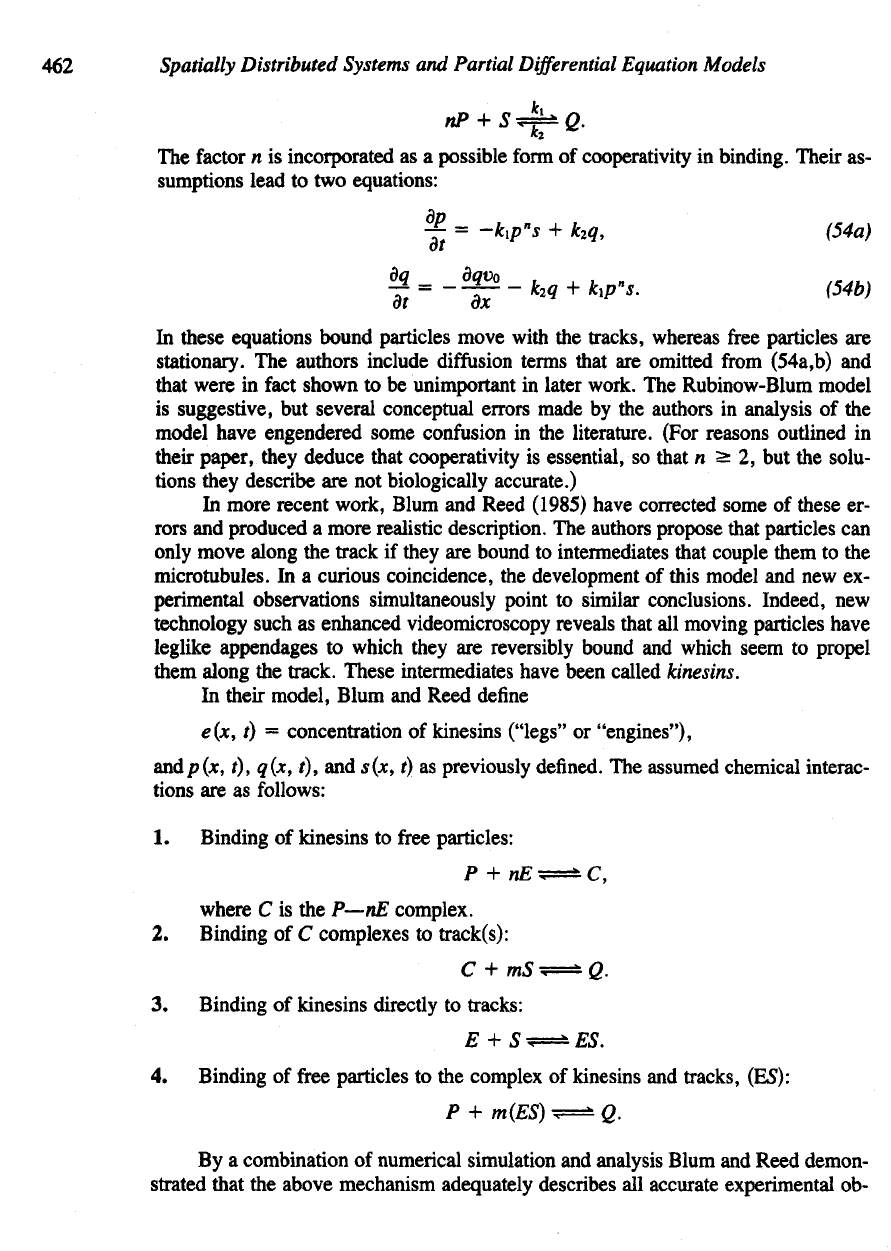
462
Spatially
Distributed
Systems
and
Partial
Differential
Equation
Models
The
factor
n is
incorporated
as a
possible
form
of
cooperativity
in
binding. Their
as-
sumptions lead
to two
equations:
In
these equations bound particles move
with
the
tracks, whereas
free
particles
are
stationary.
The
authors include
diffusion
terms that
are
omitted
from
(54a,b)
and
that
were
in
fact
shown
to be
unimportant
in
later work.
The
Rubinow-Blum model
is
suggestive,
but
several conceptual errors made
by the
authors
in
analysis
of the
model have engendered some
confusion
in the
literature. (For reasons outlined
in
their paper, they deduce that cooperativity
is
essential,
so
that
n ^ 2, but the
solu-
ns they describe
are not
biologically accurate.)
In
more recent work,
Blum
and
Reed (1985) have corrected some
of
these
er-
and
produced
a
more realistic description.
The
authors propose that particles
can
only
move along
the
track
if
they
are
bound
to
intermediates that couple them
to the
microtubules.
In a
curious coincidence,
the
development
of
this model
and new ex-
perimental observations simultaneously point
to
similar conclusions. Indeed,
new
technology such
as
enhanced videomicroscopy reveals that
all
moving particles have
leglike appendages
to
which they
are
reversibly bound
and
which seem
to
propel
them
along
the
track. These intermediates have been called kinesins.
In
their model,
Blum
and
Reed
define
e(x,
t) =
concentration
of
kinesins
("legs"
or
"engines"),
andp(x,
t),
q(x,
/), and
s(x,
t) as
previously
defined.
The
assumed chemical interac-
tions
are as
follows:
1.
Binding
of
kinesins
to
free
particles:
where
C is the
P—nE
complex.
2.
Binding
of C
complexes
to
track(s):
3.
Bin ctly
to
tracks:
4.
Binding
of free
particles
to the
complex
of
kinesins
and
tracks,
(ES):
By
a
combination
of
numerical simulation
and
analysis Blum
and
Reed demon-
strated that
the
above mechanism adequately describes
all
accurate experimental
ob-
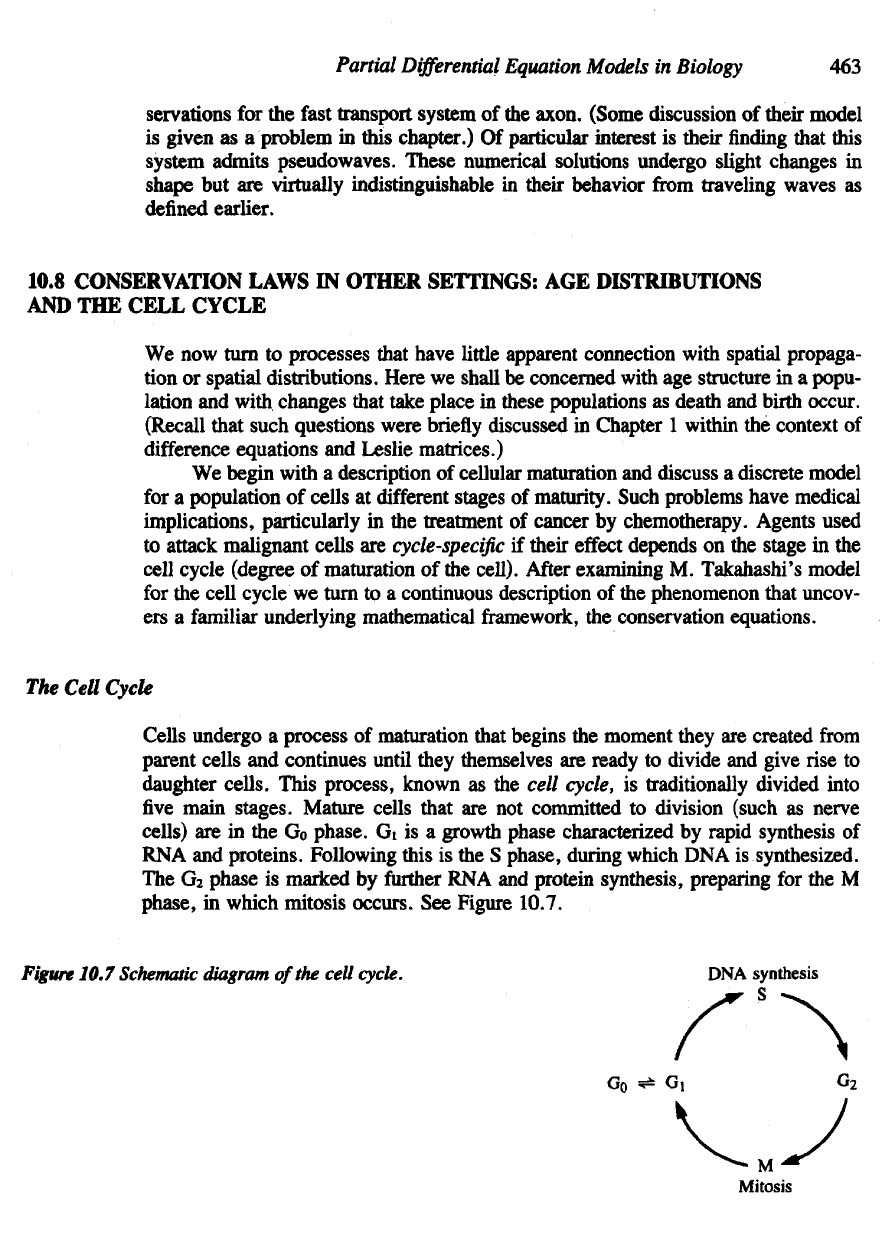
Partial
Differential
Equation
Models
in
Biology
463
servations
for the
fast
transport system
of the
axon. (Some discussion
of
their model
is
given
as a
problem
in
this chapter.)
Of
particular interest
is
their
finding
that this
system admits pseudowaves. These numerical solutions undergo slight changes
in
shape
but are
virtually indistinguishable
in
their behavior
from
traveling waves
as
defined
earlier.
10.8 NSERVATION LAWS
IN
OTHER SETTINGS:
AGE
DISTRIBUTIONS
AND
THE
CELL CYCLE
We
now
turn
to
processes
that have little apparent connection with spatial propaga-
tion
or
spatial distributions. Here
we
shall
be
concerned with
age
structure
in a
popu-
lation
and
with changes that take place
in
these populations
as
death
and
birth occur.
(Recall that such questions were
briefly
discussed
in
Chapter
1
within
the
context
of
difference
equations
and
Leslie matrices.)
We
begin with
a
description
of
cellular maturation
and
discuss
a
discrete model
for
a
population
of
cells
at
different
stages
of
maturity. Such problems have medical
implications, particularly
in the
treatment
of
cancer
by
chemotherapy. Agents used
to
attack malignant
cells
are
cycle-specific
if
their
effect
depends
on the
stage
in the
cell
cycle
(degree
of
maturation
of the
cell).
After
examining
M.
Takahashi's model
for
the
cell
cycle
we
turn
to a
continuous description
of the
phenomenon that uncov-
ers a
familiar underlying mathematical
framework,
the
conservation equations.
The
Cell
Cycle
Cells undergo
a
process
of
maturation that begins
the
moment they
are
created
from
parent
cells
and
continues until they themselves
are
ready
to
divide
and
give
rise to
daughter
cells.
This
process,
known
as the
cell
cycle,
is
traditionally divided into
five
main
stages. Mature cells that
are not
committed
to
division (such
as
nerve
cells)
are in the Go
phase,
d is a
growth phase characterized
by
rapid synthesis
of
RNA
and
proteins. Following this
is the S
phase, during which
DNA is
synthesized.
The G
2
phase
is
marked
by
further
RNA and
protein synthesis, preparing
for the M
phase,
in
which mitosis occurs.
See
Figure 10.7.
Figure
20.7 Schematic diagram
of
the
cell cycle.
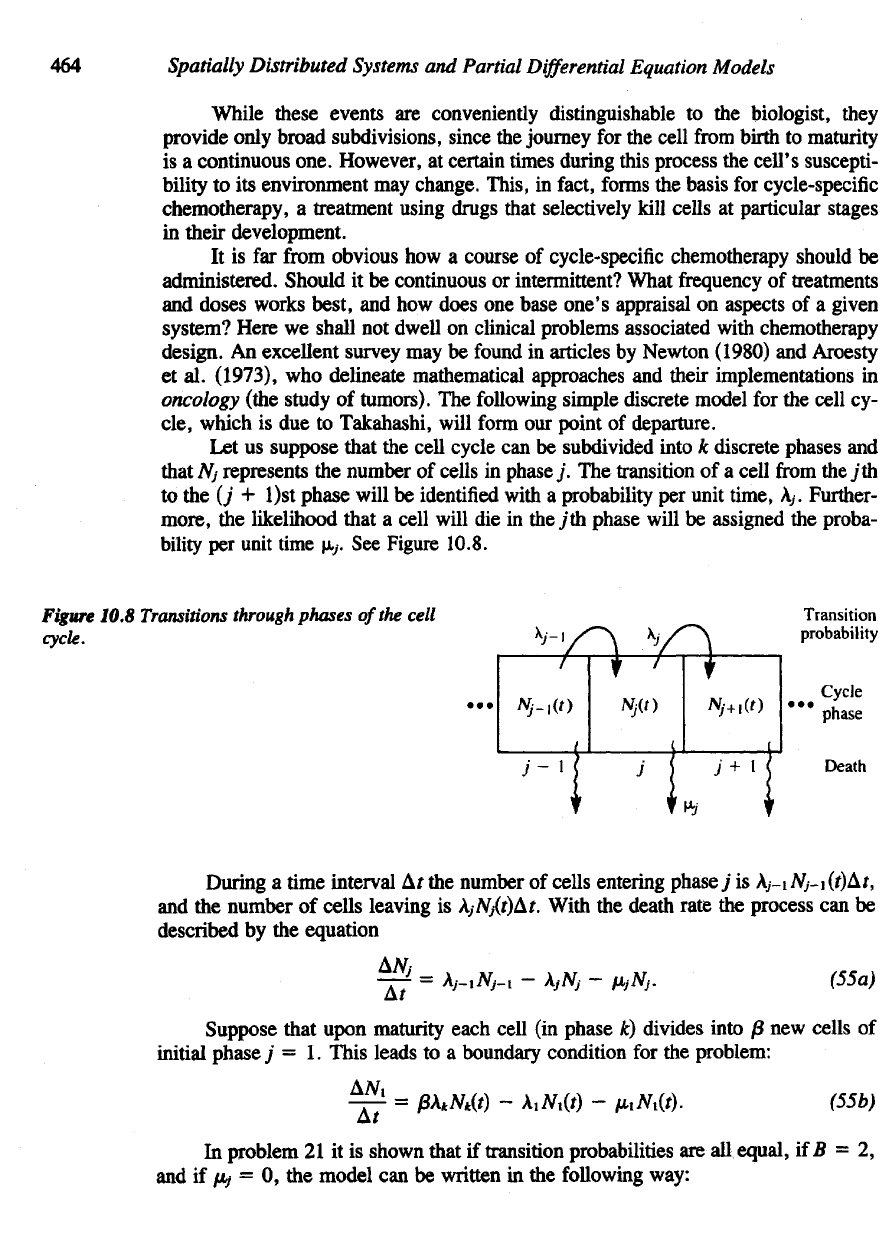
464
Spatially
Distributed
Systems
and
Partial
Differential
Equation
Models
While these events
are
conveniently distinguishable
to the
biologist, they
pr e only broad subdivisions, since
the
journey
for the
cell
from
birth
to
maturity
is a
ntinuous one. However,
at
certain times during this process
the
cell's
suscepti-
bility
to its
environment
may
change. This,
in
fact,
forms
the
basis
for
cycle-specific
chemotherapy,
a
treatment using drugs
that
selectively kill cells
at
particular stages
in
their
development.
It is far
from
obvious
how a
course
of
cycle-specific chemotherapy should
be
administered. Should
it be
continuous
or
intermittent? What
frequency
of
treatments
and
doses works
best,
and how
does
one
base one's appraisal
on
aspects
of a
given
system? Here
we
shall
not
dwell
on
clinical problems associated with chemotherapy
design.
An
excellent
survey
may be
found
in
articles
by
Newton (1980)
and
Aroesty
et
al.
(1973),
who
delineate
mathematical approaches
and
their implementations
in
oncology
(the study
of
tumors).
The
following simple discrete model
for the
cell
cy-
cle, which
is due to
Takahashi, will
form
our
point
of
departure.
Let us
suppose that
the
cell
cycle
can be
subdivided into
k
discrete phases
and
that
Nj
represents
the
number
of
cells
in
phase
j. The
transition
of a
cell
from
they'th
to the (j +
l)st phase will
be
identified
with
a
probability
per
unit
time,
A/.
Further-
more,
the
likelihood
that
a
cell will
die in the
y'th phase will
be
assigned
the
proba-
bility
per
unit
time
jx,.
See
Figure
10.8.
Figure 10.8 Transitions through phases
of
the
cell
cycle.
During
a time
interval
A/ the
number
of
cells
entering phase./
is
A/-IA(/-i(f)Af,
and
the
number
of
cells
leaving
is
A/Af/f)Af.
With
the
death rate
the
process
can be
described
by the
equation
Suppose that upon maturity each cell
(in
phase
k)
divides into
ft new
cells
of
initial phase 7=1. This leads
to a
boundary condition
for the
pr
In
problem
21 it is
shown that
if
transition probabilities
are all
equal,
if B = 2,
and if
/LA,
= 0, the
model
can be
written
hi the
following way:
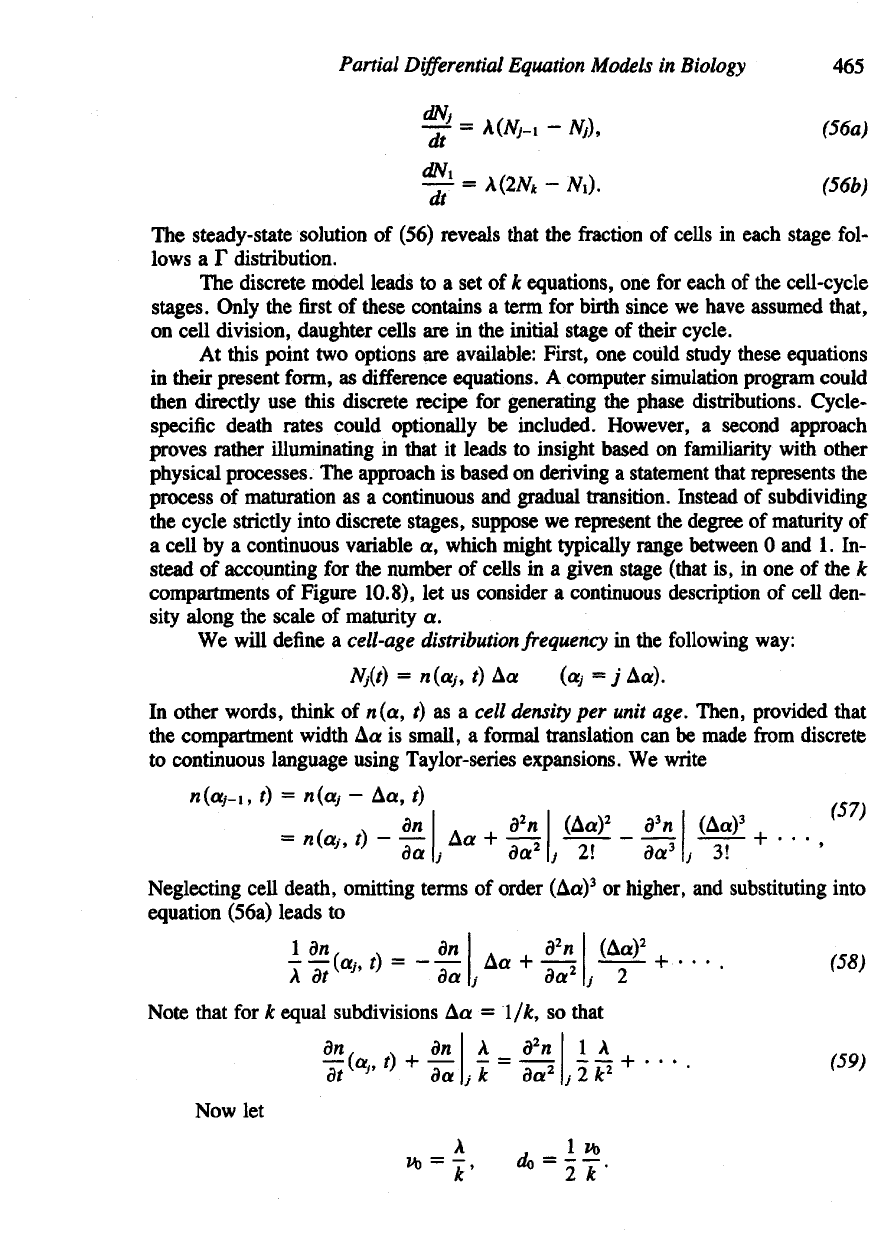
Partial
Differential
Equation
Models
in
Biology
465
The
steady-state solution
of
(56) reveals that
the
fraction
of
cells
in
each stage fol-
lows
a F
distribution.
The
discrete model leads
to a set of k
equations,
one for
each
of the
cell-cycle
stages.
Only
the first of
these contains
a
term
for
birth since
we
have assumed mat,
on
cell
division, daughter cells
are in the
initial stage
of
their cycle.
At
this point
two
options
are
available:
First,
one
could study these equations
in
their present form,
as
difference
equations.
A
computer simulation program could
then
directly
use
this discrete recipe
for
generating
the
phase distributions. Cycle-
specific
death rates could optionally
be
included. However,
a
second approach
proves rather illuminating
in
that
it
leads
to
insight based
on
familiarity with other
physical
processes.
The
approach
is
based
on
deriving
a
statement that represents
the
process
of
maturation
as a
continuous
and
gradual transition. Instead
of
subdividing
the
cycle strictly into discrete stages, suppose
we
represent
the
degree
of
maturity
of
a
cell
by a
continuous variable
a,
which might typically range between
0 and 1. In-
stead
of
accounting
for the
number
of
cells
in a
given stage
(that
is, in one of the k
compartments
of
Figure
10.8),
let us
consider
a
continuous description
of
cell den-
sity along
the
scale
of
maturity
a.
We
will
define
a
cell-age
distribution
frequency in the
following
way:
Nj(t)
= n
(a,,
t) Aa (a, = j
Aa).
In
other words, think
of
n(a,
t) as a
cell
density
per
unit
age. Then, provided that
the
compartment width
Aa is
small,
a
formal
translation
can be
made
from
discrete
to
continuous language using Taylor-series expansions.
We
write
Neglecting
cell
death, omitting terms
of
order (Aa)
3
or
higher,
and
substituting into
equation (56a) leads
to
Note that
for k
equal subdivisions
Aa =
1/fc,
so
that
Now
let
